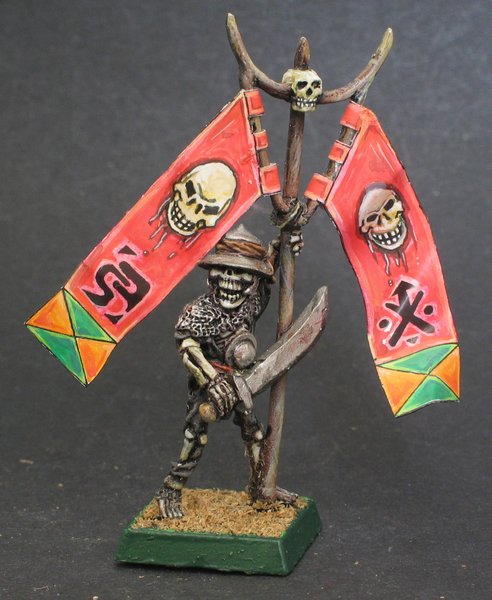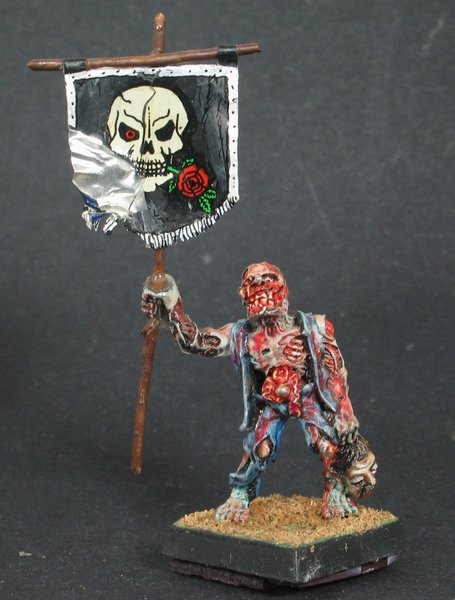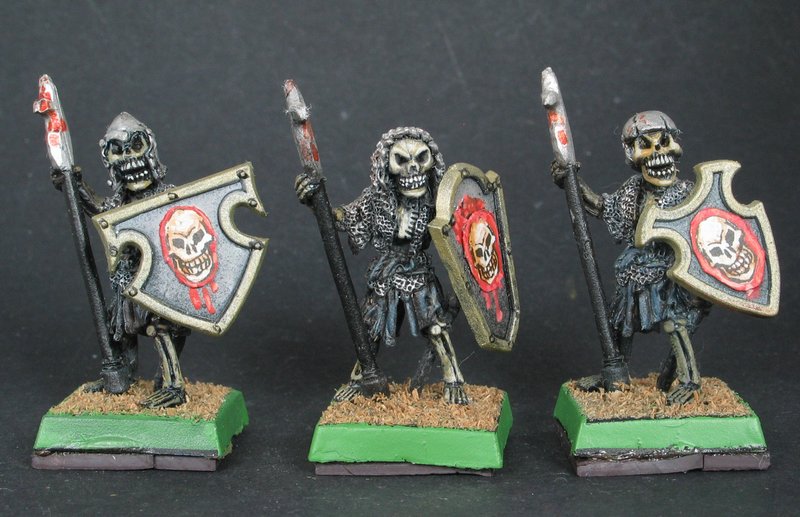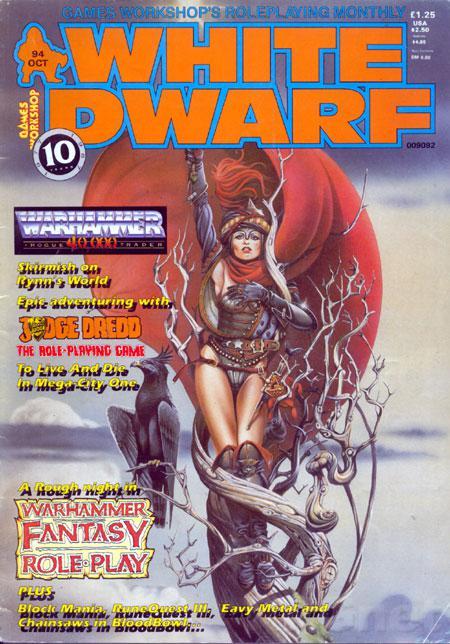 |
I spent hours as a boy studying this picture. I used to wonder who all the characters
were. The 'Good' races are depicted here in force; dwarf, elf and human... all
victorious and defiant in the face of devilish horror. |
Welcome back to 'Acceptable in the '80s', Orlygg's history of Warhammer Fantasy Third Edition through its articles, products and miniature releases. This endeavour is the sister project of 'Dark Technologies' over of Realm of Chaos's sister site;
Warhammer 40,000: A Rogue Trader Blog. Today's post actually begins the era of Third Edition, though the previous posts in the series have discussed Bob 'Iron Claw' Olley's contribution to retro fantasy gaming and the miniature releases advertised in White Dwarf 94.
Before we continue I should really outline what the purpose of 'Acceptable in the '80s' actually is... Well, it is my attempt to tell the story of Third Edition (and any associated, however loosely, games) through the published articles, miniature releases, supplements and other related products. I shall be discussing each in turn and attempting to review them. No real scores need to be attributed to these reviews, as written opinion has far more depth than a mere number, and my views can act as catalyst to other Citadel fans and collectors who 'were there, man!' As I have done with 'Dark Technologies, the first 'proper' article in this series discussing the launch issue of WFB3 and a follow article will discuss in further detail, 'Marginalia', where Richard Halliwell (the main author of Warhammer in its earliest guises, the the WFB was 'mostly' authored by Rick Priestley) discusses the design decisions behind the game.
However, that is all in the future....
 |
The disturbing orange horizon would make a brilliant painted background
fit around a gaming table, wouldn't it! I might have to have a go one day. |
The launch begins with a nifty piece of text that oozes the character of Warhammer at this point in its existence... Dark and dangerous with a solid streak of British black humour. Over the next few years, as the background was developed further, the dark and dangerous side of things grew darker still, but the grim sense of humour remained. Thankfully, this was some years before the 'Skullz 'n' Spikez' approach of recent times.
"The goblins had been marching for more than a day. The night had not slowed them, nor had the coming of dawn. They had eaten on the march. Several had slept on the march, their limbs carrying them forward without the need for conscious thought. Even their Skaven allies had been hard pressed to keep up.
The goblins has a purpose. They were going to war and loot.
Especially loot."
Before moving on something must be said of John Sibbick's iconic cover painting. Its incredible isn't it. Now if you can, look at the image with fresh eyes. You're passing through a newsagent, perhaps popping in to buy some confectionery, or indeed a topshelf magazine (depending on your age), and you spot this startling image on the cover of a magazine. You stroll over. Picking up the magazine you peer closer at the picture and are amazed by the vivid, earthy colours and the dark imagination behind the picture's composition. The orange mist across the landscape offers your mind half glimpsed snatches of unseen horrors while the heroic forces of good do their upmost to smite the foul foe. The detail, the storytelling and the sheer technical brilliance of the paint job are striking, even today, and trample artistically over anything produced by GW today.
So powerful was the image, that 10 years later, it was still used on the cover of the rulebook for 4th edition. Here, it is possible to discuss the development of the image. The central figure, busy crushing the life out of a mutated, two headed goblin, is a clear representation of the cover star of Warhammer second edition, the image originally painted by John Blanche in 1983. I have always felt that the figure represented Sigmar and that the action was the battle at Black Fire Pass. Others have suggested a direct with 'Harry the Hammer' from Warhammer's First Edition.
 |
One of the great things about this article are the full colour battlescenes such as
the one shown above. Very evocative of the era we love. There a great deal
of classic models in this picture... How many can you spot? |
On to the meat of the article. After a continuation of the tale of the goblins, wargames are discussed generally. To paraphrase, wargaming has been popular for a long time and these battles with toy soldiers have usually involved the Napoleonics or The Second World War. Five years previously this had all changed with the release of Warhammer Fantasy Battle. 'With the arrival of these rules, battles between armies of orcs and dwarfs, elves and goblins, humans and, well, everyone else, became the most popular type of table top game.' This most likely do to the explosion of interest in fantasy gaming with the RPG boom of the mid to late '70s, lead unsurprisingly by Dungeons and Dragons. Subsequently, 'armies of fantastic creatures marched and counter-marched across battlefields based purely in the imagination of the players.'
The busy little boffins at GW HQ had been busy with their popular game in the subsequent years as 'this new edition was based on five years of design, development and playtesting experience, which had produced an accessible and exciting set of game rules.' The article goes on to explain that 'Warhammer Fantasy Battle Third Edition uses the same basic sequence of play as earlier versions of the game.' The BIG SELL of 3rd was the inclusion of the 'advanced rules'. These formed the bulk of the new edition and the list of additions was huge; battle chariots and their uses in combat, flying monsters, aerial combat, buildings and so on...
 |
Lovely full colour battle scenes like this really strike home how wonderful retro
battles can be. I also love all the lovely sickly '80s arcane armorial transfers! |
Obviously going for 'the complete guide for fantasy gaming', Richard Halliwell went whole hog and included 'extensive guidelines on building armies and scenery for games' as well as 'including a large section on painting a preparing Citadel miniatures as well as details about how to get the most out of buildings and scenery on the tabletop.' There are even two pages devoted to building a wargames table! Additionally, Halliwell goes on to mention the companion volume to Warhammer Fantasy Battle 3rd Edition; namely Warhammer Armies as containing 'army lists for competitive games', ready to play scenarios, new machinaries of destruction, shield and banner designs and a whole lot more.'
"The ensign was trying to speak. Foulbreath (he would have to change that name when he retired) knelt beside him and gently picked up the dying man. The ensign summoned his strength for one last effort.
'Don't go... any... further... There's two of themmmmm...'
'Warhammer Fantasy Battle always had such characters - the champions, minor heroes and major heroes of earlier editions of the game.' Things were about to change though, with a new system of creating characters; level 5, 10, 15, 20 and 25 characters in fact. Now, there was a greater emphasis on the individual hero or army general roaming the battle field and acting heroically... or, indeed, diabolically if you were playing the baddies. This subtle shift included wizards and sorcerers for the first time. Previously, magic users were very much limited to one type of magic; with WFB3 a wizard had access to all the schools of magic based on his level. New spells had been added to the magical arsenal (leg breaking being one of them) as well as comprehensive rules for magic weapons, armour and duels between rival wizards.
 |
The photograph here shows a rear view shot of the thin, elven line. The undead
sure look scary from this angle! And the 'Red Dragon' makes its first appearance too... |
Other changes to the rules saw specific type of troops appearing; elite shock troops and missile support, flagellants, scouts, foresters, suicide bombers (now, sadly, not just an aspect of fantasy gaming), falconers and many, many more. For me, its the sheer amount of variables and modifiers that these changes brought in that makes WFB3 so special. There are just so many different things to try out and tinker with. Additionally, we have all the wacky Warhammer humour with Skaven poisoned wind globes and, of course, the crazy goblin fanatics that make the game unique.
In a move towards creating a more 'realistic' fantasy world (if such an oxymoron is possible), new rules were introduced to help gamers deal with baggage trains, camp followers as well as gunpowder weapons. The points costs of many of these powerful weapons was carefully balanced to ensure that creating gun toting units of dwarfs armed with magical blunderbuses was going to be an expensive process. Full rules were also provided IN A SINGLE BOOK so you didn't (and still don't) need any further publication to play WFB3 than the standard rule book. The supplements, Warhammer Armies, Siege, Realm of Chaos 1 and 2, add to the product and bring a great deal of additional ideas to the table top. There was no need to buy an additional 'army book' to get the most out of the game. Nor was there any need to wait for years until your favourite army was updated, you could just do it yourself.

An influential publication released for WFB2 was called Ravening Hordes. Think of the detail and ideas inside this book as WFB2.5. Many of the concepts introduced here would be expanded and adapted to suit WFB3. Halliwell explains one of these concepts in more detail in the article, its manouevres for units, and these rules in particular are one of the most popular retro themes in WFB3. 'The ability to manouevre up to three times per turn is based on the leadership of the unit. Troops can wheel, spread out and turn again - but only if there commander is of sufficient calibre. Well lead units have an added flexibility that is not just reflected in their killing power.
Units can adopt specific formations; the square (good against cavalry charges), wedges, archer wedges, shield walls (which are immovable, in one senses than one), testudos (the 'tortoise' of over lapping shields), and mixed units of different troop types, such as spearmen and missile troops. The advanced rules for movement compliment the advanced combat rules, which allow units to push back the opposition, multiple unit combat, continuous charges and voluntary withdrawls from battle. This overall effect is to add several layers of 'realism' to the rules...'
A further dimension that 3rd Edition brought to the game was the ability to ride monstrous creatures into battle. 'Basically, any large beast can be ridden into battle by smaller, less powerful creatures or troops, causing havoc among the enemy. On the other hand, war beasts can cause havoc to their own side by running amok in the heat of battle. Even if they are killed, creatures such as mammoths can cause problems with their death throes.'
 |
| That Red Dragon gets everwhere! |
As a young gamer, my favourite section of the rulebook was always the bestiary. I'd spend hour after happy hour reading about the habits of different creatures. This, and Out of The Pit, were my bedtime staples for a long time. The pictures and texts fired my imagination and I still love a good flick through this section today. But to the old school layman, what does this section of the book entail, Halliwell continued, 'intelligent races are covered in depth. The complete Citadel ranges of humans, dwarfs, elves, goblins, skaven, orcs, snotlings and all the others are covered in full detail... But there are other fighting races available. There are complete details of the major type of creatures that can take part in battles. The giant races, including the giants themselves with their many combat options, ogres minotaurs and treemen with their magical abilities are all part of the game. And if they wasn't enough, there are skeletons, zombies, wraiths and other undead; 'ordinary' creatures; and demons and elementals that can be summoned during battles; and of course, dragons...'
Yes, all those creatures in a single book.
The lot!
The article also goes on to describe mutation in the form of chaos attributes. Though massively expanded in Realms of Chaos, the WFB3 rulebook even had a rudimentary section on these attributes and the effect they had on the creatures concerned. Linked to this, were the expanded rules concerning psychology. Animosity and saga animosity were new introductions to the ruleset.
Phew!
 |
I have always loved that yellow and blue undead banner. I must have ago at
creating my own version one of these days. |
To conclude then... Well the article certainly suggests that its a powerhouse of a publication. Looking over the book now its vast, even when compared to the most recent publication of the book. Comparing the two, one thing strikes me... and that thing is, depth. Far more of the WFB3 is taken up by actual rules (in fact, its nearly the whole book) and there are enough of them within its chaotically coloured pages to keep a gamer in ideas for, well, ever. No reams of reams of pretty coloured pictures of miniatures here. One thing that more recent edition does have over its forebear is a decent section on building terrain, but you cannot have everything, right?
Reading through the article certainly got me all fired about about 3rd edition once again.
Hopefully, it will have the same effect on you!
Go on, be inspired!
Orlygg.



















































